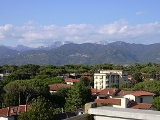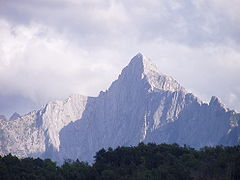
Alpi Apuane
Encyclopedia

Mountain range
A mountain range is a single, large mass consisting of a succession of mountains or narrowly spaced mountain ridges, with or without peaks, closely related in position, direction, formation, and age; a component part of a mountain system or of a mountain chain...
in northern Tuscany
Tuscany
Tuscany is a region in Italy. It has an area of about 23,000 square kilometres and a population of about 3.75 million inhabitants. The regional capital is Florence ....
, Italy
Italy
Italy , officially the Italian Republic languages]] under the European Charter for Regional or Minority Languages. In each of these, Italy's official name is as follows:;;;;;;;;), is a unitary parliamentary republic in South-Central Europe. To the north it borders France, Switzerland, Austria and...
, part of the Apennine Mountains
Apennine mountains
The Apennines or Apennine Mountains or Greek oros but just as often used alone as a noun. The ancient Greeks and Romans typically but not always used "mountain" in the singular to mean one or a range; thus, "the Apennine mountain" refers to the entire chain and is translated "the Apennine...
. They are included between the valleys of the Serchio
Serchio
At 126 kilometres the Serchio is the third longest river in the Italian region of Tuscany, coming after the Arno and the Ombrone...
and Magra
Magra
The Magra is a 62 km river of Northern Italy, which runs through Pontremoli, Villafranca in Lunigiana and Aulla in the province of Massa-Carrara ; Santo Stefano di Magra, Vezzano Ligure, Arcola, Sarzana and Ameglia in the province of La Spezia .In Roman times it was known as the Macra and marked...
rivers, and, to north-west, the Garfagnana
Garfagnana
Garfagnana is an historical region of Italy, today part of the province of Lucca in the Apennines, in northwest Tuscany, but before the unification of Italy it belonged to the Duchy of Modena and Reggio, ruled by the Este family. For a short time, in the 16th century, it was governed by the poet...
and Lunigiana
Lunigiana
The Lunigiana is an historical territory of Italy, which today falls within the provinces of La Spezia and Massa Carrara. Its borders derive from the ancient Roman settlement, later the medieval diocese of Luni, which no longer exists....
. The name derives from that of the Apuani Ligures
Ligures
The Ligures were an ancient people who gave their name to Liguria, a region of north-western Italy.-Classical sources:...
tribe who lived here in ancient times.
Geology and geography
The chain formed in the middle TriassicTriassic
The Triassic is a geologic period and system that extends from about 250 to 200 Mya . As the first period of the Mesozoic Era, the Triassic follows the Permian and is followed by the Jurassic. Both the start and end of the Triassic are marked by major extinction events...
period, somewhat earlier than the rest of the Apennines, and on a rather different geological structure, formed by a sea landscape. Karst topography
Karst topography
Karst topography is a geologic formation shaped by the dissolution of a layer or layers of soluble bedrock, usually carbonate rock such as limestone or dolomite, but has also been documented for weathering resistant rocks like quartzite given the right conditions.Due to subterranean drainage, there...
is widespread, as well as the marble
Marble
Marble is a metamorphic rock composed of recrystallized carbonate minerals, most commonly calcite or dolomite.Geologists use the term "marble" to refer to metamorphosed limestone; however stonemasons use the term more broadly to encompass unmetamorphosed limestone.Marble is commonly used for...
rocks (including the world famous Carrara marble) for which the area is renowned.
The highest peak is the Monte Pisanino
Monte Pisanino
Monte Pisanino is the highest peak in the Alpi Apuane, in Tuscany, central Italy. Located in the comune of Minucciano , it is also the highest mountain entirely belonging to the Tuscany region....
(1,946 m).
Main peaks
- Monte PisaninoMonte PisaninoMonte Pisanino is the highest peak in the Alpi Apuane, in Tuscany, central Italy. Located in the comune of Minucciano , it is also the highest mountain entirely belonging to the Tuscany region....
(1,946 m) - Monte TamburaMonte TamburaMonte Tambura is a mountain in the Alpi Apuane, in Tuscany, central Italy. It is the second highest peak in the chain after Monte Pisanino. Located on the boundary between the province of Lucca and the province of Massa-Carrara, the Tambura is part of the Natural Regional Park of the Alpi Apuane....
(1,890 m) - Monte Cavallo (1,888 m)
- Pania della CrocePania della CrocePania della Croce is a mountain in the Alpi Apuane, in Tuscany, central Italy. It is the highest peak in the Panie Group , located not far from the Tyrrhenian Sea coast....
(1,858 m) - Monte Grondìlice (1,808 m)
- Monte Contrario (1,788 m)
- Pizzo d'Uccello (1,781 m)
- Monte Sumbra (1765 m)
- Monte SagroMonte SagroMonte Sagro is a mountain in the Alpi Apuane, in Tuscany, central Italy, overlooking the city of Carrara.It is located in the northern part of the range, and, being mostly composed of marble of renowned quality, is home to several quarries...
(1,749 m)

